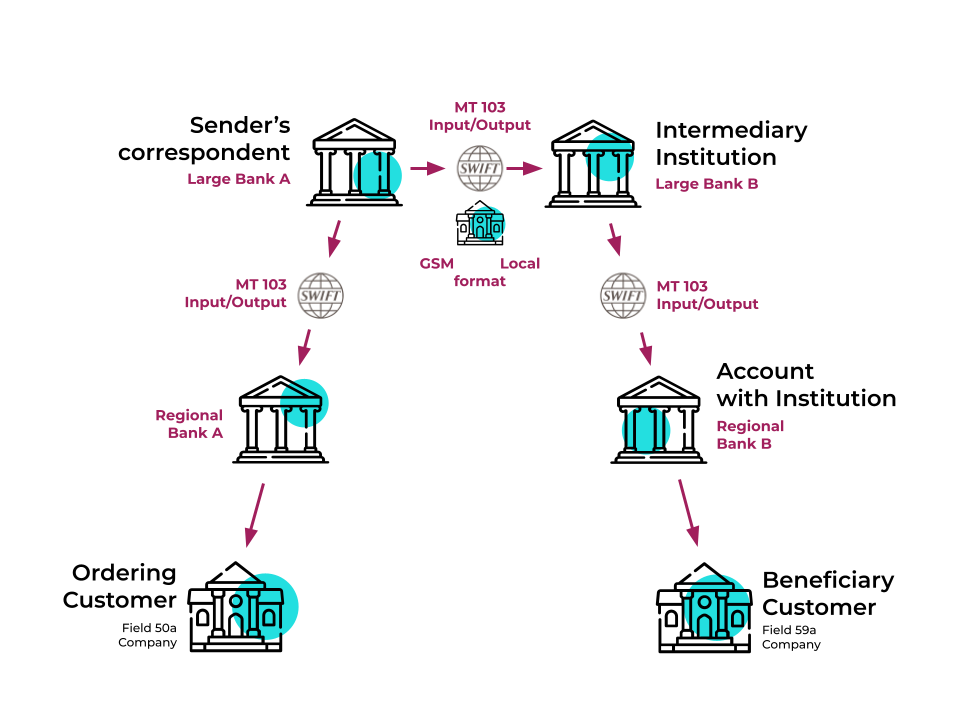SWIFT WIRE Transfers
API References for WIRE Payments:
What is SWIFT?
The SWIFT (Society for Worldwide Interbank Financial Telecommunication) payment system is a global messaging network that empowers secure and efficient international financial transactions. It plays a pivotal role in facilitating cross-border transfers, ensuring the smooth movement of funds across different financial institutions worldwide.
Who Uses the SWIFT Payment System?
The SWIFT payment system is utilized by various entities involved in international financial transactions, including banks, financial institutions, corporations, and individuals. It serves as the backbone for secure communication and settlement between these parties, enabling efficient cross-border fund transfers and ensuring adherence to regulatory and compliance requirements.
Why Use the SWIFT Payment System?
Here are some reasons why entities prefer the SWIFT payment system for international money movement:
-
Global Reach: SWIFT provides a global network that connects thousands of financial institutions across the world. This extensive network allows for seamless communication and facilitates transactions with counterparties in different countries. It ensures efficient cross-border payments, making it a preferred choice for international transactions.
-
Secure and Standardized: SWIFT employs robust security measures and standardized messaging formats, ensuring the confidentiality, integrity, and authenticity of financial information exchanged between participating institutions. This enhances trust and mitigates the risk of fraud or unauthorized access during cross-border transactions.
-
Comprehensive Messaging: SWIFT messages carry detailed transactional information, including beneficiary details, payment instructions, and additional information required for international transfers. This comprehensive messaging capability enables accurate and transparent processing of cross-border payments, ensuring compliance with regulatory and reporting obligations.
-
Foreign Exchange (FX) Integration: The SWIFT network seamlessly integrates with foreign exchange systems, enabling efficient currency conversions during cross-border transactions. This feature simplifies the complexity of dealing with multiple currencies and facilitates streamlined FX operations for entities involved in international trade and finance.
-
High-Value and Urgent Payments: SWIFT specializes in processing high-value and time-sensitive payments. It offers real-time visibility and tracking of transactions, ensuring the timely movement of funds and reducing settlement risks associated with cross-border transfers involving significant amounts.
-
Regulatory Compliance: The SWIFT payment system adheres to global regulatory frameworks, including anti-money laundering (AML) and know-your-customer (KYC) regulations. Its compliance-oriented approach ensures that entities using the SWIFT system meet international standards, making it a reliable choice for cross-border transactions with regulatory requirements.
The SWIFT payment system excels in facilitating secure and efficient cross-border payments, ensuring compliance with international standards, and offering comprehensive messaging capabilities. It is the go-to solution for entities engaged in international trade, multinational corporations, and financial institutions requiring seamless and secure global fund transfers.
In summary, the SWIFT payment system acts as a crucial facilitator of secure and efficient international financial transactions. Its global reach, standardized messaging, comprehensive transaction information, and compliance-oriented approach make it the preferred choice for entities involved in cross-border transfers, providing the necessary infrastructure for seamless global financial operations.
Use Cases for SWIFT Payments
SWIFT payments are widely used in various scenarios, including:
- International business transactions
- Cross-border fund transfers
- Payment settlements between financial institutions
- Supplier payments in different currencies
- Interbank transfers
Example Scenario: A Business Making a SWIFT Payment to Another Business
- Business A, an international manufacturing company, needs to pay Business B, a supplier of raw materials, located in a different country.
- Business A initiates a SWIFT payment through their financial institution, using the MBanq Cloud API.
- The SWIFT payment ensures a secure and reliable transfer of funds from Business A's account to Business B's account, ensuring timely payment and smooth business operations.

Let's break down the step-by-step process of how the SWIFT payment system works, including the roles of the ordering company, beneficiary customer, sender's correspondent, intermediary institution, and the MT103 message:
-
Ordering Company:
The ordering company is the entity initiating the payment. It could be a business or individual who wishes to transfer funds to a beneficiary customer, typically in another country. The ordering company provides the necessary payment instructions and details to their financial institution, known as the sender's correspondent. -
Beneficiary Customer:
The beneficiary customer is the ultimate recipient of the payment. They are the company or individual who will receive the funds sent through the SWIFT payment system. The beneficiary customer provides their bank account details to the ordering company, which are required for the payment to be properly credited to their account. -
Sender's Correspondent:
The sender's correspondent, which is typically the ordering company's financial institution, acts as an intermediary between the ordering company and the SWIFT network. The sender's correspondent receives the payment instructions from the ordering company and initiates the payment process on their behalf. They format the payment instructions into the SWIFT message format and transmit it to the SWIFT network. -
Intermediary Institution:
An intermediary institution may come into play if the payment needs to pass through one or more financial institutions before reaching the beneficiary customer's bank. These institutions act as intermediaries to facilitate the routing and processing of the payment. They help ensure that the payment reaches the correct destination and comply with any regulatory requirements along the way. -
MT103 Input/Output:
The MT103 is a specific message type used in the SWIFT payment system. It represents the format and content of the payment instructions transmitted between financial institutions. The ordering company's financial institution (sender's correspondent) creates an MT103 message, containing details such as the payment amount, currency, beneficiary customer's account details, and any additional information related to the payment. This MT103 message is sent over the SWIFT network to the beneficiary customer's bank, which is the receiver's correspondent.
Cutoff Times
Wire transfers have cutoff times because the partner banks have account reconciliation obligations with the SWIFT Network. Mbanq's SWIFT Wire cutoff times are:
Cutoff Time | Origination and Settlement Time |
|---|---|
3:00 PM PT | Sent the Same Business Day |
Updated 7 months ago
